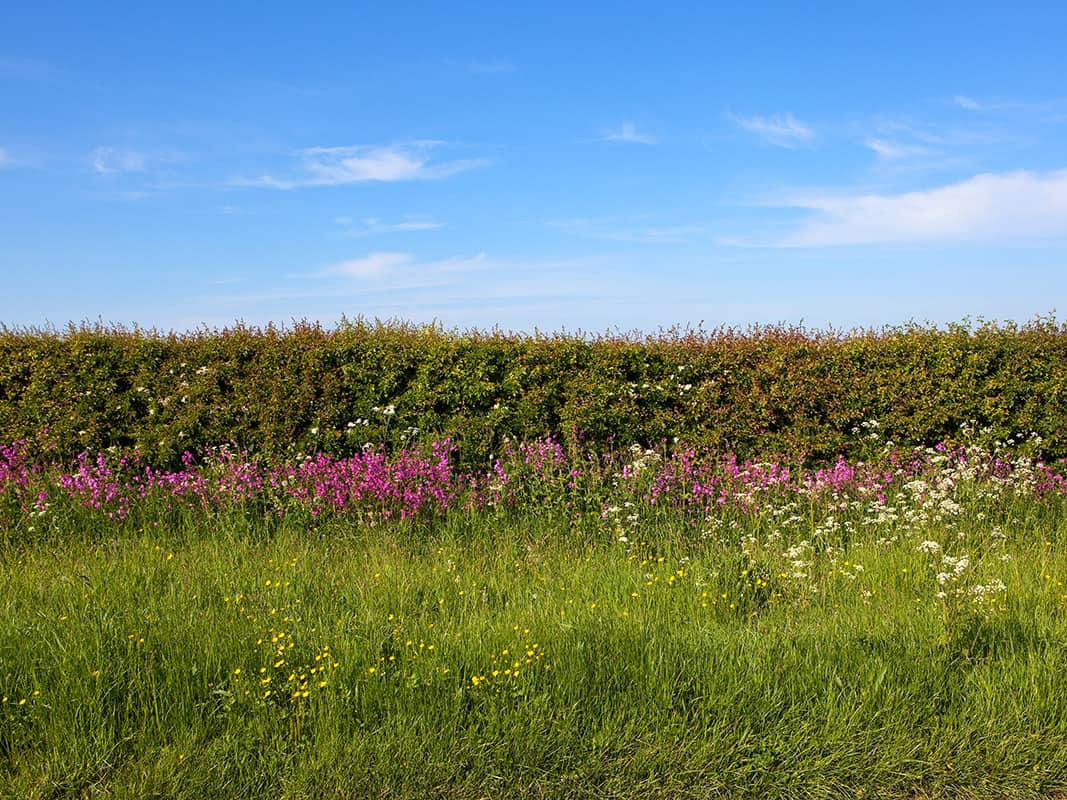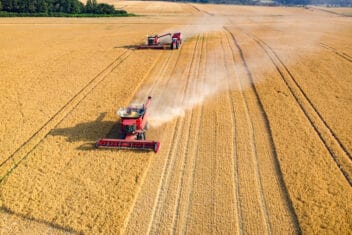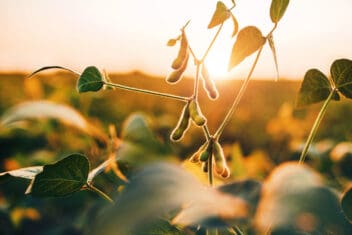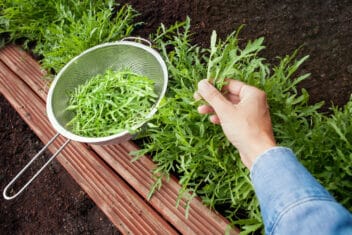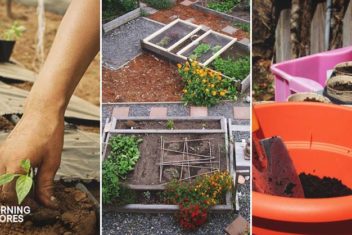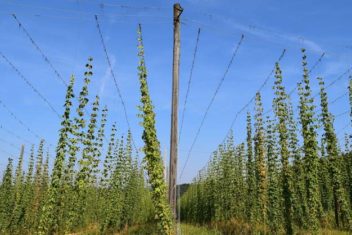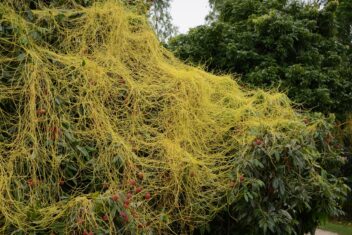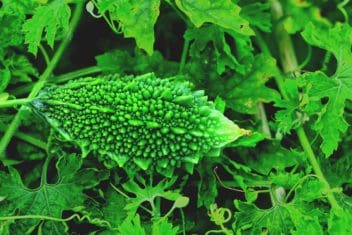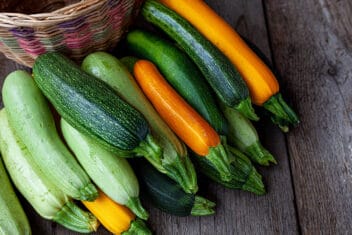Hedgerows are plantings of perennial herbs, bushes, and small trees placed in strategic areas on your property.
A hedgerow is different from a hedge, which is essentially a pretty property divider in a residential area. A hedge usually consists of a single species that is typically planted in a long line to mark the end of one area from another.
While it defines and beautifies an area, hedgerows are usually made up of several species and offer many additional benefits to your garden. Ready to learn more?
Why You Need a Hedgerow
A hedgerow greatly benefits your homestead in more ways than one. It improves biodiversity, protects from the wind, helps stop erosion, offers food to local fauna, and adds beauty to your home.
Unlike a hedge, which is typically made out of stereotypical (not to mention sometimes boring) species such as boxwood, hawthorn, or ewe, hedgerows add diverse plants to the garden that serve a useful purpose beyond just aesthetics.
Here’s what a hedgerow can do for your garden:
1. Increase Biodiversity
The hedgerow increases biodiversity by providing food and shelter for numerous species of birds and insects, as well as other animals. Those species benefit your garden enormously.
Insects provide the pollination necessary for your vegetables to produce fruits, and birds eat insects that damage your plants.
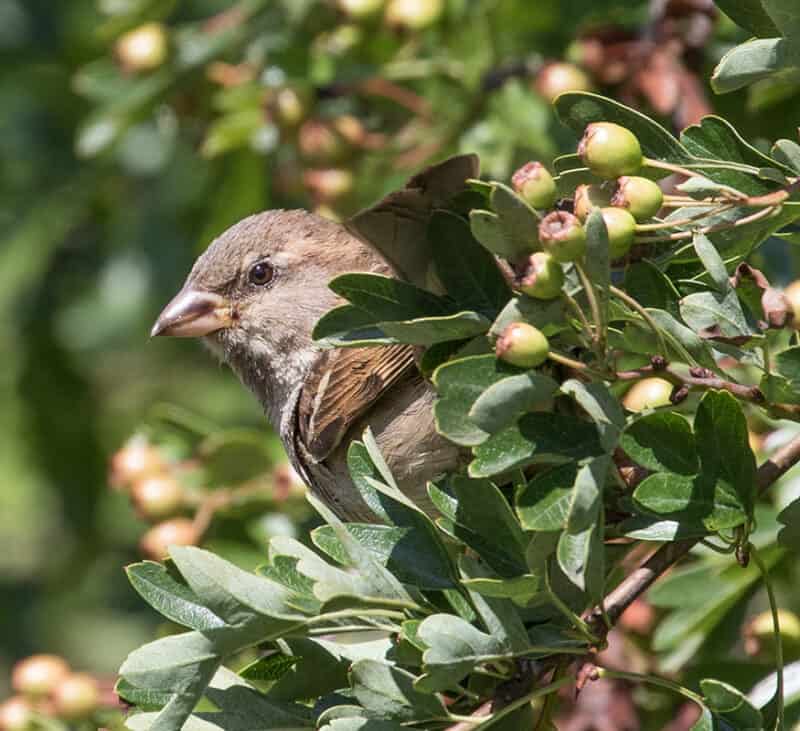
If you’re a hunter, you may want to attract deer and wild turkeys by planting food species they enjoy eating.
You can also support the wildlife in your area who are suffering from habitat loss, including salamanders, snakes, and foxes.
The Virginia opossum eats thousands of ticks a week. Allowing opossums to live in a hedgerow alongside a livestock field will benefit your animals.
2. Wind Breaks
This may be the age-old reason to plant a hedgerow. Hedgerows can protect from inclement weather because they buffer fields and gardens from winds and intense storms.
In the heat of the summer, wind can be extremely damaging to plants. The air removes moisture from the soil, causing stress, which can reduce flowering and fruit reduction.
In the winter, wind can cause burn on the foliage.
The effectiveness of buffering the wind depends on the height and type of hedgerow you create. However, the basic accepted formula is if your hedgerow is ten feet tall, it will protect an area 100 feet out.
Many people plant a hedgerow near their home as a windbreak because it helps to reduce heating and air conditioning costs. A strategically planted windbreak will also provide shade for a home or barnyard.
Obviously, evergreens provide a better year-round windbreak. However, deciduous trees buffer the wind as well, even when they don’t have leaves. A diverse hedgerow will help reduce wind speed considerably.
These plants make a great windbreak:
- Alder
- Black Locust
- Hackberry
- Oak
- Poplar
- Walnut
3. Water Conservation
Hedgerows conserve water in two ways. First, by blocking the wind, you’re also conserving moisture in the soil. Second, the root systems of the trees and shrubs in your hedgerow collect and release water, assisting the plants around them.
Using native plants, in particular, will also help you save on irrigation costs since they tend to use less water.
On the flip side, in early spring rains, the trees and shrubs will help absorb excess water so your fields can more quickly dry out for spring planting.
If your land is hilly, plant your hedgerow on the contour so that it will prevent erosion as it absorbs the flowing water.
These plants work well for preventing erosion and improving wet areas:
- Cattail
- Elderberry
- Flowering Dogwood
- Gooseberry
- Hazelnut
- Highbush cranberry
- Lilac
- Miscanthus grass
- Pussy Willow
- Staghorn Sumac
4. Increase Light
Did you know plants can amplify light? Your hedgerows can bounce light off their leaves, targeting that light on a garden area next to it.
We often think of trees and shrubs as providing shade, which they do directly beneath them. However, light is reflected off their leaves, and the light waves bounce outward. This means more light going onto your garden plants.
Why haven’t you noticed this effect with your shrubs and trees? Because they aren’t concentrated together into a broad area, the result isn’t as distinct.
With a hedgerow, the lighting effect is amplified, particularly if you use plants with glossy or light-colored leaves.
5. Increase Your Crops
With a hedgerow, you get double (or triple) duty. On top of the other benefits we’ve discussed, it provides you with another place to put an edible crop.
Brambles such as blackberries and black raspberries are popular hedge crops, as are blueberries and elderberry.

You can plant medicinal herbs along the edge of your hedgerows such as yarrow, chicory, and echinacea for a companion-growing effect.
6. Help Livestock
A hedgerow offers many advantages when used around livestock areas. Established rows can help keep livestock where they belong, and they can divide larger fields into smaller sections so that you can rotate your pastures.
Hedgerows also provide animals shelter from storms and the hot sun. They provide a pleasant place for your animals to lay down and rest during the day.
Plus, there’s plenty to go around if you have a large hedgerow! It can provide food for animals and for you. And if the brambles or wild roses get too thick you can just let your goats do some pruning.
7. Improve the Soil
Beneficial plants can fix nitrogen and bring up other nutrients from the soil.
Check out these nitrogen-fixing plants:
- Acacia
- Alder
- Black Locust
- Crimson Clover
- Dutch White Clover
- False Indigo
- Goumi
- Kentucky Coffee
- Lead Plant
- Maryland Senna
- Mesquite
- Redbud
- Round Headed Bush Clover
- White Prairie Clover
- Yellow Bush Lupine
8. Food For Pollinators
Not only will a hedgerow provide food for you and your animals, but it can also feed honeybees, butterflies, and bumblebees. You can even place your hives near the hedgerow to capitalize on this.
These plants can attract pollinators:
- False Indigo
- Flowering dogwood
- Lilac
- Maryland Senna
- Red Osier dogwood
- Witch Hazel
- Anise Hyssop
- Calendula
- Clover
- Dandelion
- Fennel
- Russian Comfrey
- Yarrow
9. Double Duty Fences
More than just a barrier to divide a space, hedgerows also make good fences.
In Great Britain, some hedgerows are hundreds of years old. Farmers maintain them by cutting out old growth and occasionally trimming. If a gap happens due to a plant dying, they put another in its place.
The result is a thick fence that even cattle can’t penetrate. Try these good fence options:
- Boxwoods
- Holly Bushes
- Junipers
- Mahonia
- Yews
10. Improved Aesthetics
Diverse hedgerows are a thing of beauty. They produce numerous spring flowers on trees and bushes followed by summer flowers with perennial herbs and an array of color in the fall.
Also, like the suburban hedge, a diverse hedgerow can be a living privacy screen. This will give an open natural feel to your property, different from a fence with make you feel closed in.
11. Noise Reduction
Is your homestead not quite as far in the city or roadway as you may like? Or you may be part of the growing group of urban farmers. A hedgerow will benefit you in another critical area: Noise reduction.
The leaves of plants absorb noise and make it seem more muted. You may need to give the hedgerow a few years to reach maturity, but it will eventually block noise from nearby roads and neighbors.
These plants are particularly good at stopping noise:
- Boxwoods
- Holly Bushes
- Junipers
- Mahonia
- Yews
- Pines
- Sassafrass
How to Build Your Hedgerow
A hedgerow usually consists of multiple types of plants. Think of it as similar to a food forest. You want a top level made up of trees, with shrubs below. Fill in the understory with different, low growing plants that can handle shade.
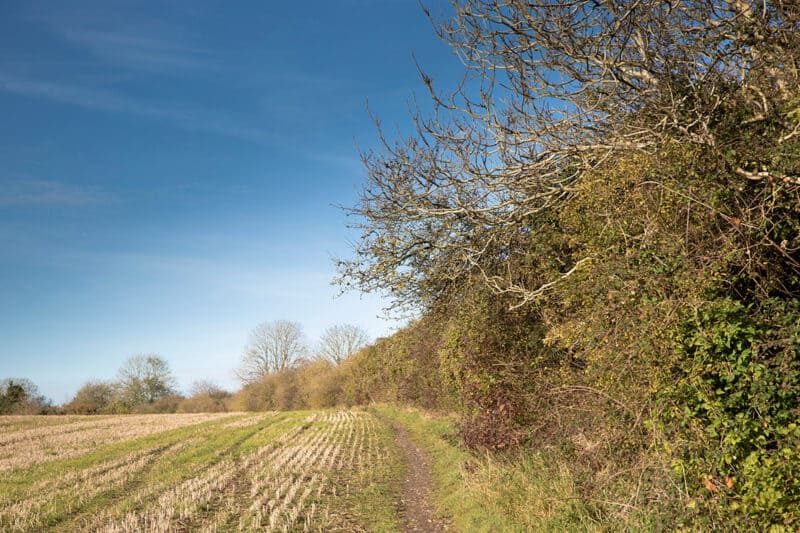
Convinced a hedgerow is ideal for your homestead? Here’s how to go about growing one of your own.
Diversity is Key
Diversity is all-important when planting a hedgerow. This is not a “planting” of a small fruit crop in a row. A hedgerow is a diverse mixture of plants that form their own ecosystem and benefit the surrounding gardens and fields.
Your hedgerow should include both evergreen and deciduous plants. Talk to your local extension office. Find out which native plants in your area provide food and shelter for birds and wildlife.
For instance, in my area crabapples, black raspberries, willow, rugosa rose, cedars, and dogwoods are all great hedgerow plants.
Take some time to plan for diversity. You want a mix of plant species as well as a variety of shapes and sizes.
Look at the bloom time and choose plants and trees that bloom across different seasons. This will provide consistent food to insects, birds, and other animals.
Pick Native Plants
Choose native plants for your hedgerow. Native plants will be hardy in your agricultural zone.
You don’t want a hedgerow full of plants that need to be babied because you are growing them where they don’t belong. The point of having a hedgerow is to benefit the farm and lessen the workload.
Prepare Your Site
Take the time to prepare your site. Sometimes it’s easiest to do your hedgerow in sections, especially if your finished segment will be several hundred feet long.
Chunk out your hedgerow in 25-50 foot sections. Then plow a six-foot-wide strip.
Take a soil sample and find out what nutrients your soil needs. Till in compost, leaves, straw, and fertilizer to build up good soil for your seedlings.
Planting
Map out your area so that you have taller trees in the center and the ends. Put shrubs and smaller trees in the middle, and herbs and perennials along the perimeter.
In this case, you want to plant your seedlings slightly closer than is normally recommended. Your goal is to have everything grow tightly together to make a tight grouping.
Also, think about your composition as far as shading. Which direction will the afternoon sun be? Plant sun-loving plants where they will not be shaded by growing trees.
Maintenance
The good news is, the more established your planting becomes, the less care it will need. In the first year or two, your budding hedgerow will need watering and weeding to help the young plants get established.
As the hedgerow grows, you may need to occasionally trim or mow along the edges to keep it from spreading into the field or garden area. When garden work is slow in winter, you can take some pruners and trim away deadwood in the hedgerow.
A hedgerow is a worthwhile investment, but to reduce costs you can ask your friends and family if you can look in their woodlots or gardens for seedlings or cuttings.
Take the time and care to establish a hedgerow and it will pay you back tenfold.
